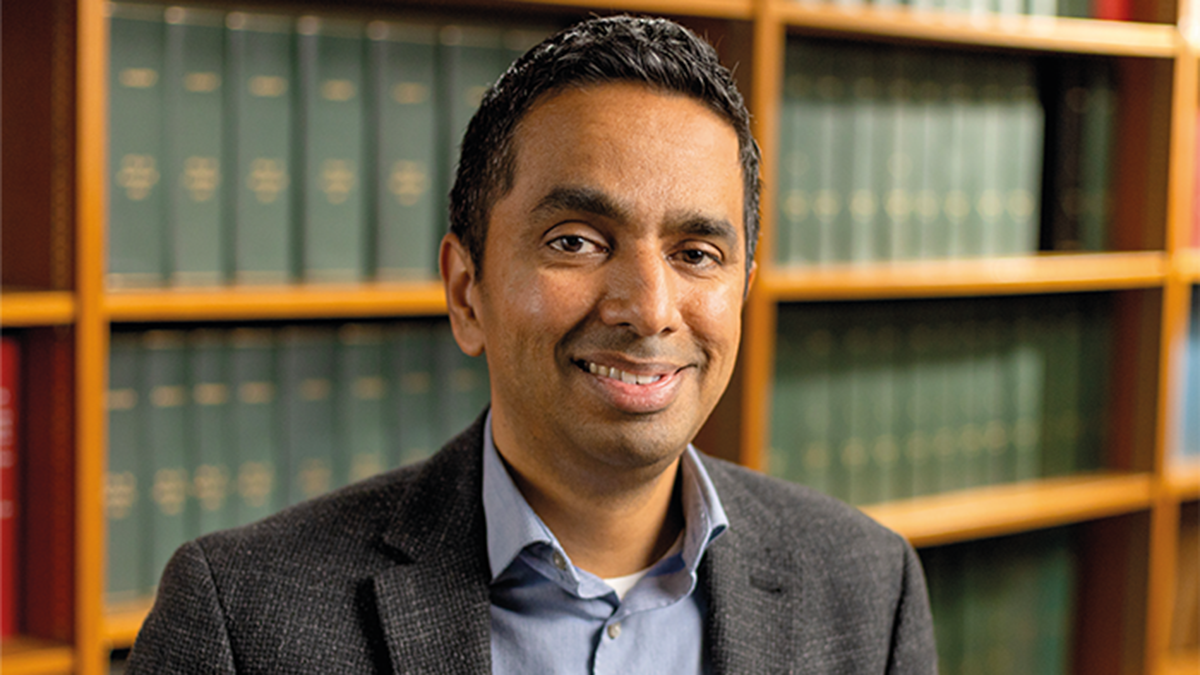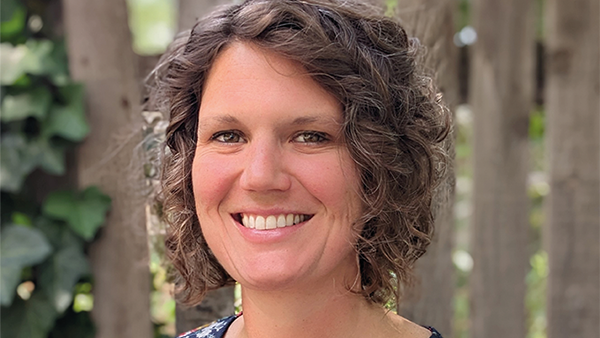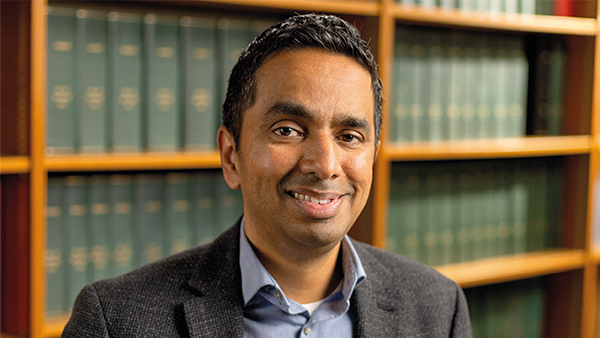A Collaborative and Future-Focused Diagnostic Career
Sitting Down With… Linoj Samuel, clinical microbiologist and leader in infectious disease diagnostics
What was your route into clinical microbiology and virology?
I’ve been interested in infectious diseases since high school, where I enjoyed reading about outbreaks and observing healthcare responses to them. Though I grew up in the Middle East, I trained as a medical lab scientist with a focus on microbiology and immunology as an undergraduate in India.
Once I realized I needed a doctoral degree to advance my career, I moved to the US to study medical microbiology and immunology at the University of Arizona, focusing on tuberculosis research. Specifically, I examined immune responses to tuberculosis infections and how we could improve diagnostic testing. After that, I wanted to shift track from basic research to my original area of interest- clinical microbiology.
I completed a two-year fellowship in a program accredited by the American Society for Microbiology (ASM) at the University of Rochester, where I trained in clinical, scientific, and administrative aspects of diagnostic and public health microbiology. This experience included working with infectious disease providers and pathologists to develop diagnostic tests.
After completing my fellowship in 2007, I moved to Michigan to become the division head of clinical microbiology at Henry Ford Health, where I’ve been ever since. There’s never a dull moment and I enjoy the diverse challenges, especially collaborating with different specialties like transplant, cancer, and infectious disease. Of course, having family nearby is a bonus! It’s a constantly changing and challenging field, which keeps me engaged.
You’ve worked extensively on rapid near-patient diagnostics. What do you consider your most significant achievement in this area – and how has it impacted patient care?
Rapid primary care diagnostics have made significant strides. One key achievement was consolidating labs within Henry Ford Health, which operates a 24/7 lab facility with specialized, highly trained staff. This setup allows us to provide high-quality care across the system. However, there are situations where near-patient testing is necessary.
We established around 15 locations across Southeast Michigan that offer near-patient molecular testing, including real-time PCR testing for flu, COVID-19, and RSV, which ensure the same high-quality results as those from our main lab. Early investments in this technology translated into better patient outcomes, allowing clinicians to make faster and more informed treatment decisions, such as whether to admit patients.
By collaborating closely with colleagues in emergency departments and urgent care centers, we demonstrated the benefits of near-patient testing, such as better antiviral and antibiotic use and improved decision-making. We presented this data at medical meetings to highlight the positive impact on patient care.
When COVID-19 hit in 2020, the groundwork we had laid with near-patient testing helped us deliver timely results during the peak of the pandemic. We decentralized testing, which eased pressure on our main lab and allowed providers to make faster decisions, ultimately improving patient care and resource management.
Your research also explores better resource utilization and diagnostic stewardship – can you tell us more about this?
Clinical microbiology is experiencing rapid technological advances, which is exciting but also challenging. It’s important to adopt new technologies not just because they’re innovative, but because they truly benefit patients.
Our research has recently focused on rapid antibiotic susceptibility testing. Traditionally, microbiology has been limited by the need to wait for bacterial cultures to grow, which can delay patient care. Though we’ve made strides with mass spectrometry for faster bacterial identification, susceptibility testing still takes time. And that can result in patients staying in the hospital longer than necessary – not ideal for patient comfort nor resource management.
We’ve been working on ways to speed up this process without compromising accuracy. Our 2023 paper evaluating a new rapid antibiotic susceptibility testing device (1) has been highlighted at major microbiology conferences. The device, along with a few others now FDA-approved, has the potential to significantly improve patient care by providing fast and reliable results.
What memorable moments or breakthroughs in your research career influenced your professional trajectory?
One of my most memorable experiences goes back to when I was a graduate student working on a protein called EIS in Mycobacterium tuberculosis. At the time, we speculated that it might play a role in antibiotic resistance, though its known role was in helping the bacteria survive inside cells. Fast forward 20 years, I recently worked on a tuberculosis case with potential antibiotic resistance. We sent the sample to the CDC, and it was gratifying to see that the EIS protein is now included in their panel for detecting antibiotic resistance. It was rewarding to see how the basic science work I did years ago is now applied in clinical practice. It’s not groundbreaking, but it’s a meaningful connection between research and real-world impact, as well as a reminder of how far I’ve come.
Are there any particular areas within clinical microbiology that you believe need more support?
There’s a growing need for specialists in this field – especially as it is highly specialized and rapidly evolving with the rise of antimicrobial resistance and new pathogens. Indeed, one of the key turning points in my career was completing my fellowship training program through the ASM, which helped me grow professionally. Since then, I’ve had the privilege of serving on the Clinical Microbiology Fellowship (CPEP) Committee, overseeing these programs, which are essential for training clinical microbiologists.
I believe every healthcare institution should have a dedicated medical microbiologist to manage their lab, whether it’s an MD with pathology training or PhD, with CPEP training. At Henry Ford Health, we have two microbiologists, but some places still have none. It’s important to have someone fully committed to the role, and that’s something I’ve advocated for.
I’ve also had the opportunity to chair the ASM’s Clinical Microbiology and Public Health Committee, which guides policy and advocacy for medical microbiology in the US – including training programs and the American Board of Medical Microbiology certification. Given the challenges we face, such as shortages of lab scientists and the rise of infectious diseases, it’s more important than ever to strengthen this field.
How do you balance the demands of research, clinical practice, and speaking engagements?
When I figure it out, I’ll let you know! Of course, balancing my roles as a clinical microbiologist, department leader, and volunteer within ASM is a challenge, but I’m fortunate to have strong support from the leadership at Henry Ford Health. It’s a team effort, and I’m proud to contribute to both patient care and advancing the field.
Could you share how big data and analytics are currently being utilized and what potential they hold for the future?
One of the things I appreciate about working here at Henry Ford Health is that our chair of pathology, Richard Zarbo, was an early advocate of Lean principles in labs. We’ve implemented Lean training for everyone – from administrative leaders to lab scientists – to focus on improving quality and metrics. Under Zarbo’s leadership, we even offer Lean training programs to others outside our institution that focus on utilizing metrics and data to drive improvements in clinical microbiology labs. The key is to focus on specific metrics, work on improving them, and then move on to the next. Many labs get stuck monitoring data without making real progress, so our approach emphasizes continuous improvement.
We also value communication with clinicians; their feedback helps us improve our lab processes and patient care. We’ve had success by working closely with providers, and we also collaborate with nursing leadership and education, which is a highly effective way to implement changes. Metrics can be challenging, but we’ve benefited from having an informatics team that custom-builds data analytics tools for us. Many institutions ask how we’ve achieved this, and it’s because we have a creative and supportive team.
Looking ahead, I’d love to see AI play a bigger role. Right now, the term AI is often misused, but it would be amazing if AI could help us analyze the large amounts of data we’re sitting on, answer specific questions, or even suggest new questions we should be asking to improve further.
What are the most critical considerations when implementing rapid point-of-care diagnostics – particularly in the context of infectious diseases?
When introducing any test, it’s crucial to talk to the provider first. Don’t assume how they will use it – ask them how it would affect patient care. If the test won’t change how the patient is managed or address a key need in infectious diseases, we have to question its value. We also need to consider the patient’s perspective, especially if the test is expensive. Will the patient truly benefit from it?
Often, tests are implemented simply because they’re available, but we need to carefully evaluate them from all angles before using them. In point-of-care testing, there’s a growing concern that more complex tests are being made available to patients, even though they may not change management. There needs to be a meaningful assessment to ensure near patient testing offers the most cost effective care. There is also concern about the need for adequately trained individuals to run these tests. At our facility, medical lab scientists perform molecular testing, but that’s not always the case.
We need to ensure that tests are performed by well-trained individuals to achieve high-quality results. If other people perform the tests, there should be a system – preferably overseen by someone with pathology and point-of-care experience – to monitor and track quality; it’s important to look for unusual patterns, track data, and manage the system in real time to maintain high standards of care.
Looking ahead, which areas of research within infectious disease and diagnostics do you believe hold the most promise?
One of the key areas we need to focus on is diagnostic stewardship, especially when it comes to outcome studies. These studies are difficult, particularly in infectious diseases where new diagnostic technologies are often tested in single institutions or small populations. This approach creates challenges for broader adoption and figuring out best practices for their use.
We’re also facing pushback from insurance companies questioning the economic utility of some tests. And sometimes they’re right! It’s up to us, as providers, scientists, and microbiologists, to prove the value of these diagnostics. We need to conduct studies that show whether a platform improves patient outcomes and healthcare resource use. If a test doesn’t show value, it’s important to recognize that and explore other options.
However, such studies are complex and resource-intensive. We’re now having discussions with organizations like the NIH and industry vendors to figure out how to pool resources and conduct this research to ensure we’re using the right tests at the right time and proving their impact on patient care and resource management.
What advice would you give to young scientists who are interested in following in your footsteps?
I would encourage anyone interested in the field to talk to someone who’s already in it. When I was at CPEP, I spent a lot of time speaking with people interested in entering the field and discussing career pathways. It’s important to learn from others’ experiences, so you don’t repeat the same mistakes. Networking and reaching out to people in the field can help you become a stronger candidate.
There’s a real need for new talent in lab medicine, especially given the challenges we face. Though it’s important for people to invest in becoming qualified, it’s equally important for healthcare systems to recognize the value of having this expertise in their labs. With increasing financial pressures leading to lab consolidation, we need to ensure decisions are made with patient care in mind.
For those interested in clinical microbiology, the ASM Clinical Microbiology and Public Health page is a great resource. It provides information on fellowship programs, board certification, advocacy resources, and the challenges in the field. I recommend checking it out and talking to someone in the field, whether you’re in graduate school or just exploring your options. There are plenty of people working in labs that are happy to provide support and guidance.





